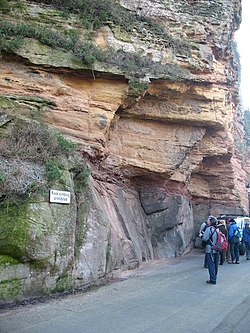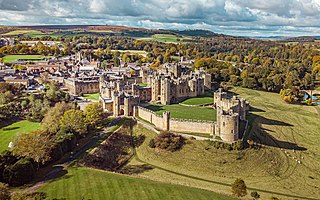
Alnwick Castle is a castle and country house in Alnwick in the English county of Northumberland. It is the seat of the 12th Duke of Northumberland, built following the Norman conquest and renovated and remodelled a number of times. It is a Grade I listed building now the home of Ralph Percy, 12th Duke of Northumberland and his family. In 2016, the castle received over 600,000 visitors per year when combined with adjacent attraction the Alnwick Garden.

Harrogate is a spa town in the district and county of North Yorkshire, England. Historically in the West Riding of Yorkshire, the town is a tourist destination and its visitor attractions include its spa waters and RHS Harlow Carr gardens. 13 miles (21 km) away from the town centre is the Yorkshire Dales National Park and the Nidderdale AONB.

Knaresborough is a market and spa town and civil parish on the River Nidd in North Yorkshire, England. It is three miles east of Harrogate and was in the Borough of Harrogate until April 2023.

PontefractCastle is a castle ruin in the town of Pontefract, in West Yorkshire, England. King Richard II is thought to have died there. It was the site of a series of famous sieges during the 17th-century English Civil War.

Sandal Castle is a ruined medieval castle in Sandal Magna, a suburb of the city of Wakefield in West Yorkshire, England, overlooking the River Calder. It was the site of royal intrigue and the setting for a scene in one of William Shakespeare's plays.
Bilton is a suburb of Harrogate, North Yorkshire, England, situated to the north-east of the town centre.

Spofforth is a village in the civil parish of Spofforth with Stockeld in the Harrogate district of North Yorkshire, England, about 3 miles (4.8 km) north west of Wetherby and 5 miles (8 km) south of Harrogate on the River Crimple, a tributary of the River Nidd.

Killinghall is a village and civil parish in the Harrogate district of North Yorkshire, England. The civil parish population taken at the 2011 census was 4,132.
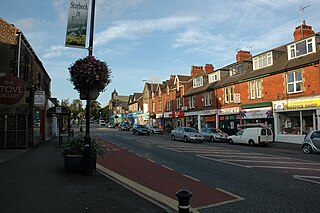
Starbeck is an area of Harrogate in North Yorkshire, England. The population of Starbeck Ward taken at the 2011 census was 6,226. It has many facilities, including Starbeck railway station, which serves the Harrogate Line. Frequent services depart to Harrogate, Leeds and York.
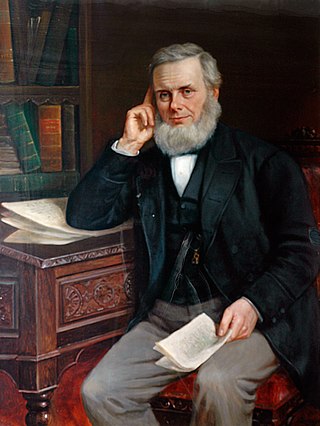
William Grainge was an English antiquarian and poet, and a historian of Yorkshire. He was born into a farming family in Dishforth and grew up on Castiles Farm near Kirkby Malzeard in the North Riding of Yorkshire, where he studied the archaeological site beneath the farm buildings, now known as Cast Hills settlement. Although he left school at age 12, he educated himself well enough to become a clerk to a solicitors' firm in Boroughbridge. He later established a bookshop in Harrogate and published numerous books on local history and topography, besides publishing a number of anonymous poems and discourses about local natural history.

Robert of Knaresborough was a British hermit who lived in a cave by the River Nidd, Knaresborough, North Yorkshire. His feast day is on the 24 of September.

John O'Gaunt's Castle was a royal hunting lodge in the West Riding of Yorkshire in England.

Peveril Castle is a ruined 11th-century castle overlooking the village of Castleton in the English county of Derbyshire. It was the main settlement of the feudal barony of William Peverel, known as the Honour of Peverel, and was founded some time between the Norman Conquest of 1066 and its first recorded mention in the Domesday Survey of 1086, by Peverel, who held lands in Nottinghamshire and Derbyshire as a tenant-in-chief of the king. The town became the economic centre of the barony. The castle has views across the Hope Valley and Cave Dale.
William de Vesci (c.1125–1184) was an Anglo-Norman feudal lord and Sheriff. Born William fitz Eustace at Knaresborough Castle, Yorkshire, the son of Eustace Fitz John and Beatrix de Vesci, he took his mother's surname.
Ely Hargrove (1741–1818) was an English bookseller and local historian.

Knaresborough Viaduct is a viaduct in the North Yorkshire town of Knaresborough, England. The viaduct carries the Harrogate line over the River Nidd in the town. The viaduct was supposed to have opened in 1848, but the first construction collapsed into the river very near to completion, which necessitated a new viaduct and delayed the opening of the line through Knaresborough by three years.
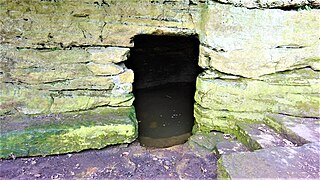
The early 13th century St Robert's Cave and Chapel of the Holy Cross also known with variants such as St Robert's Chapel and Chapel of the Holy Rood are located on Abbey Road beside the River Nidd in its gorge at Knaresborough. The cave is a rare example of a medieval hermitage, cut out of the magnesian limestone river gorge with a domestic area externally and the chapel of the Holy Cross which originally housed the saint's grave.

The Forest of Knaresborough was a royal hunting forest in Yorkshire, England. It covered an area of some 45 square miles (120 km2) west and south of the town of Knaresborough, between the River Nidd and the River Wharfe, then in the West Riding of Yorkshire and now in North Yorkshire.

Bilton Hall is a Grade II listed large country house near Harrogate, North Yorkshire. It was historically the home of the prominent Stockdale family, of which three Knaresborough MPs were members.
William de Stuteville Baron of Cottingham in the East Riding of Yorkshire, Lord of Buttercrambe in the North Riding of Yorkshire, was an English noble.


